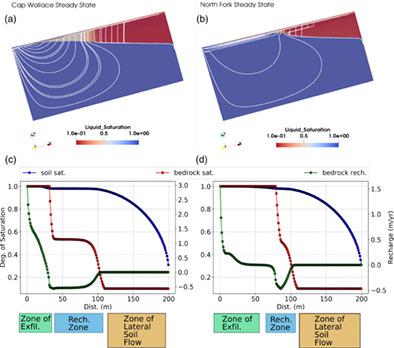当前位置:
X-MOL 学术
›
Hydrol. Process.
›
论文详情
Our official English website, www.x-mol.net, welcomes your feedback! (Note: you will need to create a separate account there.)
A numerical investigation of bedrock groundwater recharge and exfiltration on soil mantled hillslopes
Hydrological Processes ( IF 3.2 ) Pub Date : 2020-06-09 , DOI: 10.1002/hyp.13799 W. Payton Gardner 1 , Kelsey Jensco 2, 3 , Zachary Hoylman 2, 3 , Robert Livesay 2 , Marco Maneta 1, 2
Hydrological Processes ( IF 3.2 ) Pub Date : 2020-06-09 , DOI: 10.1002/hyp.13799 W. Payton Gardner 1 , Kelsey Jensco 2, 3 , Zachary Hoylman 2, 3 , Robert Livesay 2 , Marco Maneta 1, 2
Affiliation

|
Here we use Richards Equation models of variably saturated soil and bedrock groundwater flow to investigate first‐order patterns of the coupling between soil and bedrock flow systems. We utilize a Monte Carlo sensitivity analysis to identify important hillslope parameters controlling bedrock recharge and then model the transient response of bedrock and soil flow to seasonal precipitation. Our results suggest that hillslopes can be divided into three conceptual zones of groundwater interaction, (a) the zone of lateral unsaturated soil moisture accumulation (upper portion of hillslope), (b) the zone of soil saturation and bedrock recharge (middle of hillslope) and (c) the zone of saturated‐soil lateral flow and bedrock groundwater exfiltration (bottom of hillslope). Zones of groundwater interaction expand upslope during periods of precipitation and drain downslope during dry periods. The amount of water partitioned to the bedrock groundwater system a can be predicted by the ratio of bedrock to soil saturated hydraulic conductivity across a variety of hillslope configurations. Our modelled processes are qualitatively consistent with observations of shallow subsurface saturation and groundwater fluctuation on hillslopes studied in our two experimental watersheds and support a conceptual model of tightly coupled shallow and deep subsurface circulation where groundwater recharge and discharge continuously stores and releases water from longer residence time storage.
中文翻译:

土壤覆盖山坡基岩地下水补给与渗流的数值研究
在这里,我们使用可变饱和土壤和基岩地下水流的Richards方程模型来研究土壤与基岩流系统耦合的一阶模式。我们利用蒙特卡罗敏感性分析来确定控制基岩补给的重要山坡参数,然后对基岩和土壤流对季节性降水的瞬态响应进行建模。我们的研究结果表明,山坡可分为三个概念性的地下水相互作用区域:(a)侧向非饱和土壤水分积累区域(山坡上部);(b)土壤饱和度和基岩补给区域(山坡中部) (c)饱和土壤侧向流和基岩地下水渗出的区域(山坡的底部)。在降水期间,地下水相互作用区域扩大了上坡,而在干旱时期,地下水相互作用的区域则呈排水状。分配给基岩地下水系统a的水量可以通过各种坡度配置下的基岩与土壤饱和导水率之比来预测。我们的模型化过程与我们在两个实验流域中研究的斜坡上的浅层地下饱和度和地下水波动的观察定性一致,并且支持紧密耦合的浅层和深层地下循环的概念模型,在该模型中,地下水的补给和排出不断地存储和释放较长停留时间的水存储。分配给基岩地下水系统a的水量可以通过各种坡度配置下的基岩与土壤饱和导水率之比来预测。我们的建模过程与我们在两个实验流域中研究的斜坡上的浅层地下饱和度和地下水波动的观测结果在质量上相符,并且支持紧密耦合的浅层和深层地下循环的概念模型,在该模型中,地下水的补给和排出不断地存储和释放较长停留时间的水存储。分配给基岩地下水系统a的水量可以通过各种坡度配置下的基岩与土壤饱和导水率之比来预测。我们的建模过程与我们在两个实验流域中研究的斜坡上的浅层地下饱和度和地下水波动的观测结果在质量上相符,并且支持紧密耦合的浅层和深层地下循环的概念模型,在该模型中,地下水的补给和排出不断地存储和释放较长停留时间的水存储。
更新日期:2020-06-09
中文翻译:

土壤覆盖山坡基岩地下水补给与渗流的数值研究
在这里,我们使用可变饱和土壤和基岩地下水流的Richards方程模型来研究土壤与基岩流系统耦合的一阶模式。我们利用蒙特卡罗敏感性分析来确定控制基岩补给的重要山坡参数,然后对基岩和土壤流对季节性降水的瞬态响应进行建模。我们的研究结果表明,山坡可分为三个概念性的地下水相互作用区域:(a)侧向非饱和土壤水分积累区域(山坡上部);(b)土壤饱和度和基岩补给区域(山坡中部) (c)饱和土壤侧向流和基岩地下水渗出的区域(山坡的底部)。在降水期间,地下水相互作用区域扩大了上坡,而在干旱时期,地下水相互作用的区域则呈排水状。分配给基岩地下水系统a的水量可以通过各种坡度配置下的基岩与土壤饱和导水率之比来预测。我们的模型化过程与我们在两个实验流域中研究的斜坡上的浅层地下饱和度和地下水波动的观察定性一致,并且支持紧密耦合的浅层和深层地下循环的概念模型,在该模型中,地下水的补给和排出不断地存储和释放较长停留时间的水存储。分配给基岩地下水系统a的水量可以通过各种坡度配置下的基岩与土壤饱和导水率之比来预测。我们的建模过程与我们在两个实验流域中研究的斜坡上的浅层地下饱和度和地下水波动的观测结果在质量上相符,并且支持紧密耦合的浅层和深层地下循环的概念模型,在该模型中,地下水的补给和排出不断地存储和释放较长停留时间的水存储。分配给基岩地下水系统a的水量可以通过各种坡度配置下的基岩与土壤饱和导水率之比来预测。我们的建模过程与我们在两个实验流域中研究的斜坡上的浅层地下饱和度和地下水波动的观测结果在质量上相符,并且支持紧密耦合的浅层和深层地下循环的概念模型,在该模型中,地下水的补给和排出不断地存储和释放较长停留时间的水存储。


























 京公网安备 11010802027423号
京公网安备 11010802027423号